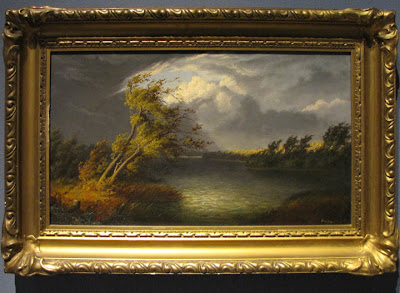 One of the places I was determined to revisit when I returned to Door County was Kangaroo Lake. It's a pretty big lake, and it's divided by a road that crosses over it, one of several roads which connect the two sides of the Door Peninsula.
One of the places I was determined to revisit when I returned to Door County was Kangaroo Lake. It's a pretty big lake, and it's divided by a road that crosses over it, one of several roads which connect the two sides of the Door Peninsula. The side of the lake that falls north of the road is closed to fishing vessels and all watercraft, swimmers, etc., and is very peaceful; people fish from that side of the road, or, like me, walk along and enjoy the reflections of lilies, reeds and sky.
The south side of the road is an active lake; there are houses around it, with docks and little motorboats; there were people waterskiing there while I was taking this picture, and a stiff breeze out of the south, so that water was all churned up.
I was reading again about mindfulness in Thich Nhat Hanh this morning, and for some reason -- you know how perfectly obvious things can just creep up on you and slap you in the face? -- it finally hit me that mindfulness is not just a sometime thing: ultimately it would be good to ALWAYS be mindful. And realizing that, I felt I had to acknowledge at least the partial truth of that old saw: "those who can, do; those who can't, teach."
Because the reason I talk so much about mindfulness and presence is probably because I'm not really all that good at it. I am VERY present when I have a camera in my hand -- which is probably why I love photography so much -- but am I present, really truly present, in my life? I don't see how I can be, because to do that well would slow me down so much: how would I ever get anything done?
As I thought about that I remembered -- with sadness -- all those times my children wanted to talk to me when they were little, and how I was always impatient for those times to end so I could go on about my important work -- whatever that might be. Or the times in Bible study when I'm not so much listening to what others have to say as I am waiting for the chance to reveal my own insights. Or the times in conversations, in coffee shops, or with my husband or his father, when part of me is tapping its fingers impatiently wishing whoever it is would get to the point.
Fortunately another voice inside spoke up before I could go too far down the road of guilt and self-criticism (and what a very well-traveled road that is!) and reminded me of all the times over the years when I've been willing to drop everything to listen: to an anxious child, sitting on my lap or calling on the phone; to (as yesterday) a real estate client who feels rushed and anxious; to a stranger or a friend who calls with a question or concern. I do -- occasionally -- take the time to pay attention to my dog, or give my cats a snuggle; I am fed by the observations of the women in my spirituality group, my friends, and my neighbor; I feed the fish and water the plants and notice the tides and the cry of the seagulls, the kingfisher, the swallows and the eagles who surround my house with sound.
Yes, the goal of mindfulness would be to be attentive all the time. But I have to be tender with my busy self, to allow for the progress I've made, to understand that my life, like Kangaroo Lake, will always have a busy side and a quiet side, and that there is a road across the center where I can stand when I'm trying to balance the two. I need to remember that even when I feel like I'm going over the edge -- and doesn't this picture have a sense of that, almost like it's the edge of the waterfall? -- that in reality I am only a step away from that center road, where I will be safe, and grounded; able to see both sides and choose what is the appropriate mode for the moment.
Hey. It's all good. Really. And maybe someday I'll get better at being both mindful and busy at the same time; there's always that hope!





























